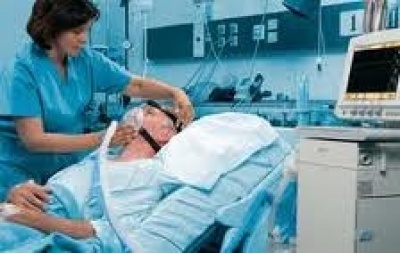
Guillain–Barré syndrome (GBS), sometimes Landry's paralysis or Guillain–Barré–Strohl syndrome, is an acute polyneuropathy, a disorder affecting the peripheral nervous system. Ascending paralysis, weakness beginning in the feet and hands and migrating towards the trunk, is the most typical symptom, and some subtypes cause change in sensation or pain, as well as dysfunction of the autonomic nervous system. It can cause life-threatening complications, in particular if the respiratory muscles are affected or if the autonomic nervous system is involved. The disease is usually triggered by an infection.
The diagnosis is usually made by nerve conduction studies and with studies of the cerebrospinal fluid. With prompt treatment by intravenous immunoglobulins or plasmapheresis, together with supportive care, the majority will recover completely. Guillain–Barré syndrome is rare, at one to two cases per 100,000 people annually, but is the most common cause of acute non-trauma-related paralysis. The syndrome is named after the French physicians Georges Guillain and Jean Alexandre Barré, who described it in 1916.
Classification
Six different subtypes of Guillain–Barré syndrome exist:
- Acute inflammatory demyelinating polyneuropathy (AIDP) is the most common form of GBS, and the term is often used synonymously with GBS. It is caused by an autoimmune response directed against Schwann cell membranes.
- Miller Fisher syndrome (MFS) is a rare variant of GBS. Accounting for about 5% of GBS cases, it manifests as a descending paralysis, proceeding in the reverse order of the more common form of GBS. It usually affects the eye muscles first and presents with the triad ofophthalmoplegia, ataxia, and areflexia. The ataxia predominantly affects the gait and trunk, with the limbs relatively spared. Anti-GQ1b antibodies are present in 90% of cases.
- Acute motor axonal neuropathy (AMAN), also known as Chinese paralytic syndrome, attacks motor nodes of Ranvier and is prevalent in China and Mexico. It is probably due to an auto-immune response directed against the axoplasm of peripheral nerves. The disease may be seasonal and recovery can be rapid. Anti-GD1a antibodies are present. Anti-GD3 antibodies are found more frequently in AMAN.
- Acute motor sensory axonal neuropathy (AMSAN) is similar to AMAN, but also affects sensory nerves with severe axonal damage. Like AMAN, it is probably due to an autoimmune response directed against the axoplasm of peripheral nerves. Recovery is slow and often incomplete.
- Acute panautonomic neuropathy is the rarest variant of GBS, sometimes accompanied by encephalopathy. It is associated with a high mortality rate, owing to cardiovascular involvement, and associated dysrhythmias. Frequently occurring symptoms include impaired sweating, lack of tear formation, photophobia, dryness of nasal and oral mucosa, itching and peeling of skin, nausea, dysphagia, and constipation unrelieved by laxatives or alternating with diarrhea. Initial nonspecific symptoms of lethargy, fatigue, headache, and decreased initiative are followed by autonomic symptoms including orthostatic lightheadedness, blurring of vision, abdominal pain, diarrhea, dryness of eyes, and disturbed micturition. The most common symptoms at onset are related to orthostatic intolerance, as well as gastrointestinal and sudomotor dysfunction. Parasympathetic impairment (abdominal pain, vomiting, constipation, ileus, urinary retention, dilated unreactive pupils; loss of accommodation) may also be observed.
- Bickerstaff's brainstem encephalitis (BBE), a further variant of Guillain–Barré syndrome, is characterized by acute onset of ophthalmoplegia, ataxia, disturbance of consciousness, hyperreflexia or Babinski's sign. The course of the disease can be monophasic or remitting-relapsing. Large, irregular hyperintense lesions located mainly in the brainstem, especially in the pons, midbrain and medulla, are described in the literature. Despite severe initial presentation, BBE usually has a good prognosis. Magnetic resonance imaging plays a critical role in the diagnosis of BBE. A considerable number of BBE patients have associated axonal Guillain–Barré syndrome, indicative that the two disorders are closely related and form a continuous spectrum.
Signs and symptomes
The disorder is characterized by symmetrical weakness that usually affects the lower limbs first, and rapidly progresses in an ascending fashion. Patients generally notice weakness in their legs, manifesting as "rubbery legs" or legs that tend to buckle, with or without dysesthesias(numbness or tingling). As the weakness progresses upward, usually over periods of hours to days, the arms and facial muscles also become affected. Frequently, the lower cranial nerves may be affected, leading to bulbar weakness, oropharyngeal dysphagia (drooling, or difficulty swallowing and/or maintaining an open airway) and respiratory difficulties. Most patients require hospitalization and about 30% require ventilatory assistance for treatment of type II respiratory failure. Facial weakness is also common. Eye movement abnormalities are not commonly seen in ascending GBS, but are a prominent feature in the Miller-Fisher variant.
Sensory loss, if present, usually takes the form of loss of proprioception (position sense) and areflexia (complete loss of deep tendon reflexes), an important feature of GBS. Loss of pain and temperature sensation is usually mild. In fact, pain is a common symptom in GBS, presenting as deep aching pain, usually in the weakened muscles, which patients compare to the pain from overexercising. These pains are self-limited and may be treated with standard analgesics. Bladder dysfunction may occur in severe cases, but is usually short-lived.
In severe cases of GBS, loss of autonomic function is common, manifesting as wide fluctuations in blood pressure, orthostatic hypotension (a fall in blood pressure on standing, leading to an increased risk of collapse), and cardiac arrhythmias.
Acute paralysis in Guillain–Barré syndrome may be related to sodium channel blocking factor in the cerebrospinal fluid. Significant issues involving intravenous salt and water administration may occur unpredictably in this patient group, resulting in SIADH, a cause of low sodium levels in the blood.

